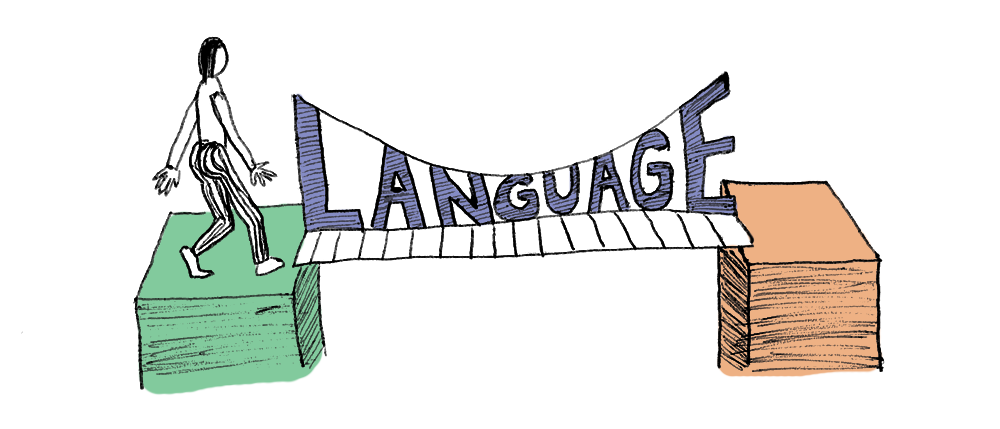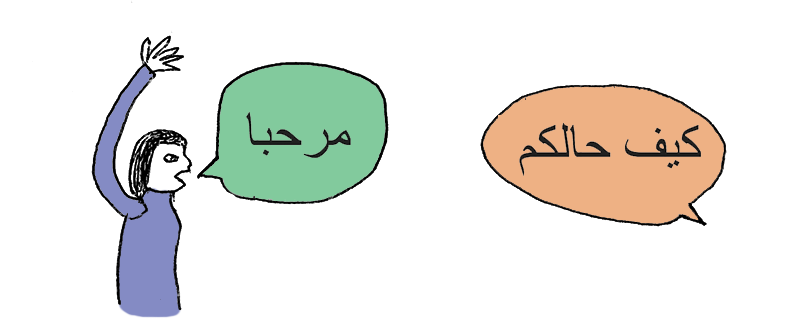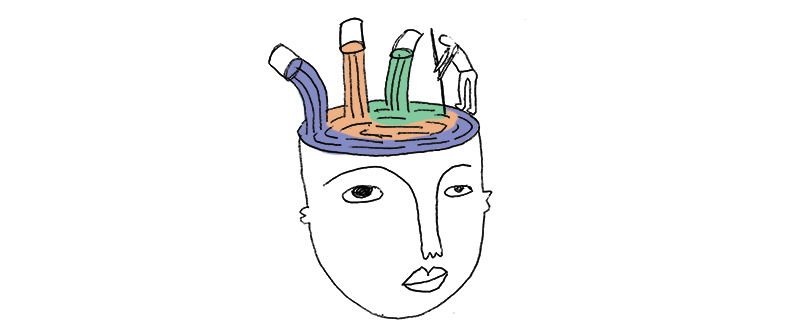Salat al-Maghrib has just begun and the courtyard in front of the mosque is full of men performing their ablutions at the communal fountain. Beneath them, a mottled shadow of wetness gathers on the pavement like a cloud. A curbside censer burning oud on the street corner billows smoke into the faces of passersby. The worst of the day’s heat has finally relented and Bahrain’s Manama souq is filling with throngs of slow-moving people, honking cars, and swerving bicycles. Walking by a coffee shop whose crowded benches overflow onto the sidewalk, I hear conversations in Arabic, Malayalam, and Farsi, the languages blending into an aural fog of lilting consonants and cascading vowels. Advertisements on nearby shop windows join the multilingual chorus, listing wares in Arabic, Urdu, English, and Tagalog. To paraphrase writer Inez Baranay, in a transcultural space like the souq, no one — not even the shop windows — is monolingual.
Bahrain, a tiny archipelago scattered off the eastern coast of Saudi Arabia, has been an influential entrepôt for millennia. From dhows anchored off shore in the Arabian Gulf, peoples and cultures and languages met and mingled, creating a legacy of diversity still exemplified in the modern souq. This dense urban landscape is a vivid tapestry of transcultural existence, with Iraqi ice cream parlors, Indian restaurants, Bangladeshi spice dealers, Syrian oud sellers, Bahraini antiques merchants, and Pakistani tailors. As a person who has spent my life navigating the nebulous borderlands between cultures, I find myself experiencing a profound sense of respite here and so I’ve been coming to the souq, one of my favorite places since childhood, almost every day, to meet friends, to shop, and to tentatively, falteringly, practice my Arabic.
The Arabic I speak is sufficient for getting by in daily life but not much more, which has always been embarrassing to me because while my passport country is the United States, my home is the Arabian Gulf. I was born here, and three generations of my family have lived here over the past 60 years. While growing up, I did pick up Arabic from my father and my friends and some from intermittent classroom study, but my acquisition of the language has always been haphazard — something I’m keen to remedy.
Spoken by more than 400 million people, Arabic is the 5th most commonly spoken language in the world. It is diglossic, meaning that one variety of the language is used in formal writing and certain speaking situations, while another variety operates in parallel for everyday communication. There is such a wide variation in vernacular Arabic — a phenomenon known as a dialect continuum — that people at opposite ends of the continuum can find it challenging to communicate because their versions of the language are so different. Written Arabic goes from right to left and typically does not include short vowels, relying instead on the reader’s ability to infer the exact word via context. There are also letters in the Arabic alphabet whose sounds are radically different from those found in English, such as ’ayn, a voiced pharyngeal fricative, which is created by making a sound in the depths of the throat. Arabic and English grammar can also differ, with Arabic often employing a verb-subject-object pattern, while English and many European languages use a subject-verb-object pattern. All this and more has led the United States School of Language Studies to classify Arabic as a Category IV “super-hard” language, meaning it is considered exceptionally difficult for native English speakers to learn. They estimate it takes a native English speaker 88 weeks (2,200 class hours) to reach professional working proficiency. In testament to the language’s difficulty, I have more than a few Arab friends who speak little to no Arabic themselves. In the Gulf, foreigners who can speak Arabic fluently are rare enough that it can garner a person a modicum of online fame, with some fluent expats boasting tens of thousands of social media followers.
With the more modest goal of simply wanting to feel confident in the language of the country I consider home, earlier this year I committed to daily Arabic lessons. I also turned off the subtitles when watching my favorite Arabic TV shows, downloaded podcasts, and filled my bookshelves with language tuition books. My Arabic-speaking friends even kindly offered to endure halting, mistake-riddled conversations with me as I struggled to come to grips with new vocabulary and complex grammar rules. But the piece of advice my Arabic teachers most kept pushing me to do was the one I was most hesitant to try: to speak Arabic in public with strangers.
I head now to one of my favorite streets in the souq, past tables of flashing toys and spice shops redolent with the scents of cardamom, cinnamon, and clove. Prayer has just finished, and I move through the milling crowd and into the souq’s fabric section. Noise immediately falls away, hushed by the rows and rows of fabric hanging from overhead rafters, stacked on tables, and draped over battered mannequins. The only sound is the chittering, insect-like whir of sewing machines emanating from every shop. I find the store with the brightly colored scarves I admired yesterday and enter, greeting the shopkeeper in Arabic. He sits on a stool, leaning back against bolts of fabric, with a cup of karak chai in hand. While I browse, we chat about the weather and nearby restaurants, he recommends a good tailor, and then I make my purchase, say good night, and step out into the muggy evening. If he thought my clunky Arabic was odd — or the fact that I was speaking it to begin with — he never once let on.
Unlike in English, where I find myself subconsciously modulating my slightly wonky accent to ensure it is as neutrally American as possible to avoid any potential questions, in Arabic I’m just not skilled enough to do that. The predominantly Sharqiyyah dialect I speak with is generously peppered with Bahraini and Hijazi pronunciation — owing to the influence of friends and teachers — and interspersed with sporadic stints of Gulf Pidgin (an emerging contact language utilized by many Gulf expatriates with its own unique linguistic quirks), all of which create an odd mix that usually quickly raises the question: where are you from?
This seemingly simple query is one that can be loaded with tension for those raised cross-culturally — with meaningful interaction between two or more cultures for a significant period of time during their formative years — because while reductionist constructions of other identity markers are increasingly being dismantled, many still view cultural origin as genetically-imbued, static, and ultimately singular. In a world that largely remains premised on essentialist notions of cultural identity, those of us deeply bound to unexpected or multiple cultures can find “where are you from?” a difficult question to answer. Over the years, we have learned that when people ask this, they often aren’t looking for the nuanced answers we have to give. When we respond honestly it can elicit increasingly pugnacious queries; some I’ve heard more times than I can count: “Can you really be American if you weren’t born in the states?,” “If you were born in the Gulf, why are you white?,” and the always dreaded, “But what are you really?”
The most antagonistic questioning occurred during my time attending university in the United States when I was what in the cross-cultural community is termed a “hidden immigrant” — someone who superficially appears to be the same as the surrounding culture but internally is profoundly different. Because of my white skin I had significant privileges not available to many immigrants, including the ability to try to blend in and avoid these questions altogether. I soon learned, however, that even doing that didn’t alleviate the dissonance I experienced being continually assumed to be something that in many ways I simply wasn’t. The relentless questioning and occasional instances of outright aggression served as reminders to me that transcultural individuals can be perceived as unwelcome challenges to essentialist approaches to identity formation.
But in the Manama souq, even when I’m speaking Arabic, these questions rarely arise because in transcultural spaces “individuals are assumed all to be different from each other to some degree; they are as various and diverse as they can be, want to be.” The souq is a space built on centuries of diversity and the threads of connection are so densely interwoven that notions of cultural or linguistic purity seem laughably absurd. “Some speak several languages fluently; some speak a couple, some many. Some speak smatterings of various languages. Everyone knows words, phrases, expressions, from various languages, people naturally blend them into the language they’re speaking. Hybrid languages proliferate.” In the souq, cultures funnel through individuals to be reshaped into any number of different expressions, which is evident in the medley of customs, languages, and styles of dress that can belong to a given person in any manner of combinations. Here, complex notions of home aren’t an academic exercise, they are the foundational truths around which people premise their lives.
As I spend hours and then entire days immersed in the Arabic language, the beauty of it engulfs me and I find myself fascinated with the etymology of certain words. Arabic dialects themselves are deeply transcultural, with words adopted from Greek, Turkish, Farsi, and the languages of the Indian subcontinent. Arabic itself has left a legacy in many European languages, owing to the 800 years of Islamic rule in the Iberian Peninsula. Portuguese, Catalan, and Valencian all retain words of Arabic origin, while the Spanish language alone has thousands of words derived from Arabic. Even English contains an array of Arabic-origin words, like apricot, algebra, caravan, elixir, jar, lime, nadir, serendipity, sofa, zenith, and zero. As I learn more about the transcultural roots and outcroppings of the Arabic language, the more I start to see all languages as vast networks circling the globe, intertwining in the most surprising ways.
As I make my way toward the back of the souq where I have plans to meet friends for dinner, I consider the Arabic term ruhh al sakan, which means “soul of a place.” Built as it was through a long process of accretion, expanding with each new wave of immigration, the very soul of the Manama souq itself feels transcultural. Overhead, the light of the setting sun picks out the finely carved details of a third-story mashrabiya — a style of projecting latticework window thought to have originated in Iraq. Some of the oldest buildings I pass still retain hints of once towering wind catchers, a Persian architectural element used to channel cooling wind into the rooms below. Nestled somewhere within these lanes there is the Arabian Gulf’s only official Jewish synagogue and passing Hadrami Avenue, spangled with garlands of jasmine and marigold, I catch sight of 200-year-old Shri Krishna Temple, the oldest Hindu temple in the Gulf. These same streets that will be decked out for Diwali will also be decorated for Eid al-Fitr, Ashura, and Christmas.
Because of this diversity, the souq is often described as a mosaic of cultures. But “mosaic,” with its connotation of strict delineations between separate entities, doesn’t quite capture the reality of transcultural space. Cultures, after all, are not distinct, homogenous units but currents of continually overlapping influence that are transformed with every interaction. Not only are archaic conceptions of airtight cultural borders inaccurate and ahistoric, they also have the potential to engender xenophobia. By manufacturing and policing strict borders between cultures, we artificially create an Other who is so foreign to us that they can be dehumanized, and from there all manner of violence can be justified. As philosopher and economist Amartya Sen writes, “the insistence . . . on a choiceless singularity of human identity not only diminishes us all, it also makes the world much more flammable . . . the main hope of harmony in our troubled world lies in the plurality of our identities.”
When we allow transcultural people to fully claim the plurality of their identities rather than forcing them to choose one side or another, we pave the way for cultures at large to do the same thing. By recognizing the transcultural elements within ourselves and within the cultures we claim, we can truly understand that we are all stranger and local, foreigner and native, in ways that are constantly evolving. When we make peace with the transcultural elements within ourselves, we can make peace with the transcultural elements in our city, nation, and world. Not in the flawed rhetoric of multiculturalism which further entrenches artificial cultural divides, but in the spirit of transculturalism, which recognizes the kaleidoscopic array of every culture’s influences and acknowledges the beautifully muddied currents of connection that unite them all.
After saying goodbye to my friends, I stroll for a bit longer, watching as the alleyways purple with shadow and the shopkeepers toss faded sheets over tables of unsold fruit. I trace my steps back through the narrow lanes, passing halwa shops, karak cafés, and the store where I bought my new shawl. Just as my teachers predicted, the more time I spend here speaking Arabic, the more I improve, because I am speaking with people who — unlike my patient friends — do not always speak slowly or simply to accommodate my skill level. The more time I spend speaking Arabic here, the more I also find myself becoming less shy about what my imperfect Arabic reveals. I’ve stopped seeing my cross-cultural identity as evidence of lack on both sides and started seeing it as a testament to my fluency in multiple worlds. My Arabic may be neither here nor there, not fully one thing or another, but as a dynamic, ever-shifting multiplicity, it inhabits linguistically the same nebulous borderland that I do — and that is exemplified in the souq itself. As someone who exists on the margins of both my birth country and the country of my citizenship, for me, the souq fits Baranay’s definition of home in that it is a place where I experience myself “as authentic without having to think about it.” The ease I enjoy here does feel like authenticity, like a great shaking off of the tension and artifice I find myself wearing in other spaces, like I have finally found a place where I can exist wholly as myself without needing any translation. •
All illustrations by Isabella Akhtarshenas.






